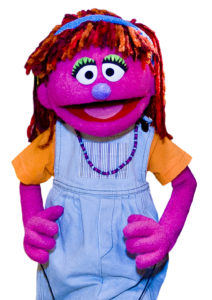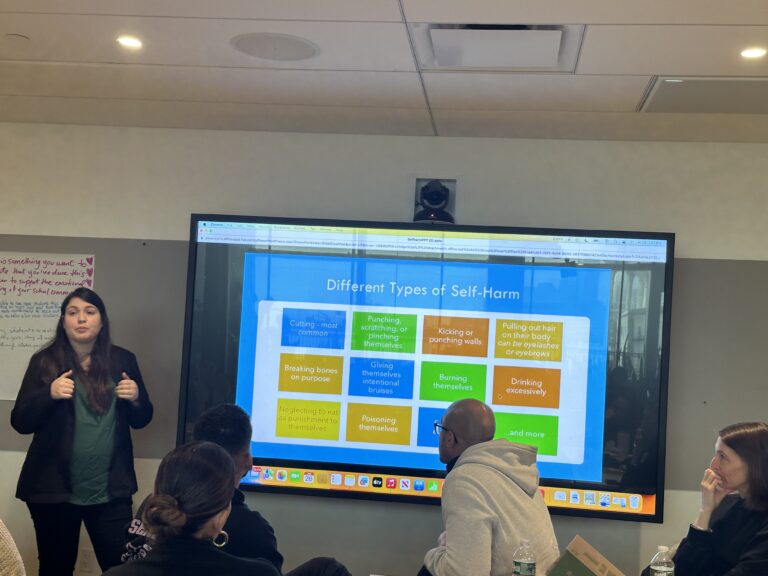Now, How to Go from Here
By Traci Donnelly, Chief Executive Officer
 Sesame Street enjoys a well-earned reputation as a trailblazer not only in children’s television, but also in our society at large. From its portrayal and integration of BIPOC (Black, Indigenous, (and) People of Color) characters in the 1970s to its more recent additions of characters with autism or incarcerated parents, it has a history of changing hearts and minds — as well as public policy. The iconic show is well on its way to doing just that for people experiencing homelessness, through the character of Lily, a 7-year-old girl whose family has lost their apartment and is living with friends, moving from home to home. Here are some things we hope Lily’s portrayal goes on to include.
Sesame Street enjoys a well-earned reputation as a trailblazer not only in children’s television, but also in our society at large. From its portrayal and integration of BIPOC (Black, Indigenous, (and) People of Color) characters in the 1970s to its more recent additions of characters with autism or incarcerated parents, it has a history of changing hearts and minds — as well as public policy. The iconic show is well on its way to doing just that for people experiencing homelessness, through the character of Lily, a 7-year-old girl whose family has lost their apartment and is living with friends, moving from home to home. Here are some things we hope Lily’s portrayal goes on to include.
First, I want to start by saying that Sesame Street’s writers have, unsurprisingly, done an impressive job so far with Lily. The scene in which painting the color purple on a rainbow reminds Lily of her old purple bedroom is heartbreaking and something many young homeless viewers will relate to. The emphasis on “home” being “more than a house or an apartment—home is wherever the love lives” is comforting. And Elmo’s and Sofia’s caring, nonjudgmental reaction to Lily’s homelessness provides parents and children alike with a blueprint of how friends and neighbors can offer the sense of community and support that kids like Lily so desperately need. Such an honest portrayal is sure to accomplish Sesame Street’s goal of helping children experiencing homelessness to feel less alone and invisible, and it also helps reduce some of the stigma associated with being homeless.
But if the show wants to get serious about reducing the stigma, one of the most powerful ways the writers could do that would be to talk about the reasons why the family became homeless.
Much like no one chooses to be diagnosed with drug addiction or diabetes, no one chooses to be homeless; it’s almost always because the family finds itself in terrible circumstances beyond their control.
For example, fleeing domestic violence is one of the main reasons families become homeless. People often wonder why a woman won’t just leave a dangerous domestic violence situation. This is exactly why: because, in essence, you are choosing to sacrifice the very roof over your head, and who would choose to make their children homeless? And so some women remain in dangerous, unhealthy relationships.
Some make a different choice: The situation they’re living in is so terrible that being homeless becomes the only option. That was the case with our client Giselle, who had grown up middle class but realized that moving with her five children to a homeless shelter was the only way they would be safe.
People often make assumptions about how anyone could end up homeless—they’re lazy and didn’t work hard enough, spent money unwisely instead of paying rent—that we know are just not true. People also tend to wonder, “How could you become homeless when you have kids?” as if it could never happen to any of us.
But rather than demoralizing and judging, we should be applauding those who have the courage to flee terrible circumstances for the sake of their children—often foregoing economic security, as Giselle did—and making one of the most frightening moves imaginable.
Domestic violence doesn’t seem to be the root cause of Lily’s family’s homelessness, but a better understanding of how Lily’s family came to be in this situation would go a long way toward fostering empathy and understanding.
The people at Sesame Street know this. Sherrie Westin, President of Global Impact and Philanthropy at Sesame Workshop, touched on the many causes of homelessness, as well as its effects on children, in a press release, saying, “We know children experiencing homelessness are often caught up in a devastating cycle of trauma— the lack of affordable housing, poverty, domestic violence, or other trauma that caused them to lose their home, the trauma of actually losing their home, and the daily trauma of the uncertainty and insecurity of being homeless.”
It’s this last point—about the daily uncertainties and insecurity of being homeless—that I really hope Sesame Street makes a greater effort to convey to its audience in that unique Sesame Street way. Because regardless of how a family ends up in this situation, one universal challenge they all have is how much the inconsistency and insecurity of being homeless can be a source of trauma for a child, and how we all have a responsibility to support a system that normalizes these children’s lives as much as possible.
The Child Center’s Prevention and Family Support programs serve a large homeless population. The children are uprooted from everything they’ve ever known. Often with nothing but plastic shopping bags of clothes, they leave the only communities they’ve ever been a part of and frequently must move far away, because spots in homeless shelters in New York City are hard to come by these days, and so they must go wherever there is an opening.
In just one of many examples I could give you, we had a family recently who lived in Queens and was getting services from us when they were moved to a shelter in Staten Island. If you’re a New Yorker, you know a commute from Staten Island to Queens would be a hardship on even the most well-resourced family, let alone one with little more than the clothes on their backs. This child’s life changed overnight. She could no longer see her best friend down the block, or the teachers who had grown to care for her. She’d be allowed to continue to attend her old school, but really, how practical is it for her to endure an hours-long commute? And we could and would continue to serve the family, but to serve a family in Staten Island when our Prevention offices are in Queens would mean that we wouldn’t be immediately accessible to families in ways they might need us, which diminishes their quality of care. It also would mean that that social worker’s whole day would be spent with that visit, which would translate into our being able to serve fewer families in total. And so the family will likely start receiving services from a different, more local agency, with a different social worker than the one they’ve grown to know and feel comfortable with.
To be uprooted like that—what does that do to a child’s trust of the world?
Clearly, the system needs to change. As Robert Cizma, our Vice President of Health Homes, Prevention, and Integrated Care, put it, “The system is set up in such a way that while it’s busily doing the big-picture right thing—like getting a family placed in a shelter as soon as possible—it sometimes fails to take into account the details.” That is why we are blessed to have an amazing staff who knows the importance of maintaining a sense of normalcy for these families, especially the children.
For example, at our Prevention programs, we do all we can to ensure kids have a regular afterschool program they can attend. The daily routine of these programs adds consistency to a life that is inherently inconsistent.
And we normalize their circumstances in seemingly small ways, too, such as making it a point to celebrate kids’ birthdays. In fact, when Giselle recently spoke at a Child Center event about her experience as a client, she mentioned how important it was that she was able to celebrate her kid’s birthday when they were homeless. But that wouldn’t have happened without our support—the kind of support that is not funded by government contract.
Think about all the ways your own children experience consistency in their daily lives, and how it gives them a sense of value and belonging. Every weekend my 11-year-old son and I walk to a neighborhood café called Locals. The staff give him a big greeting and ask him if he’s having the usual. He has other consistent adults in his life: people in our building who ask how he is, neighbors who recognize him. He doesn’t feel invisible.
By creating a community at The Child Center, we make sure the homeless children in our Prevention programs don’t feel invisible.
It seems that Sesame Street is recognizing that piece of it. In that same scene in which Lily has trouble painting the purple part of a rainbow, Sofia and Elmo make clear that Lily is part of their community.
The introduction of the character of Lily has enormous potential, because getting to know one family in particular often has more of an impact than knowing the bigger picture ever can. Imagine if parents and children alike heard Lily speak about how she had to leave her friends and her school and start anew each time they stayed at a different place. Or if Lily couldn’t join a Girl Scout troop—which is what happened to Giselle’s daughter—because she lacked a permanent address. (Incredibly, Giselle went on to start her own impressive Girl Scout troop for kids at the homeless shelter. She’s now employed by the Girl Scouts and has been able to move into permanent housing of her own. That’s part of the story of homelessness, too: the hope that things will get better, and the reality that—with the right support—it almost always does.)
When we get to know a family in this way, we are much more likely to offer our compassion, our community, and, I hope, our support for policies that help families through this toughest of circumstances.
Update, May 20, 2019: The Child Center of NY is pleased that Sesame Street Workshop has announced a new initiative to support children in foster care, through the character of Karli, who is living with a “for-now” family. The initiative is part of the Sesame Street in Communities program, which provides free, bilingual, easy-to-use resources for community providers and caregivers on a range of topics — such as homelessness and foster care. We applaud Sesame’s continuing commitment to addressing the challenges and situations of all children, especially the most vulnerable and under-represented.





